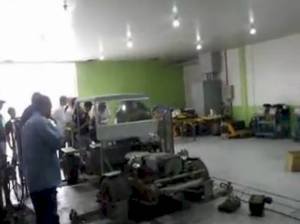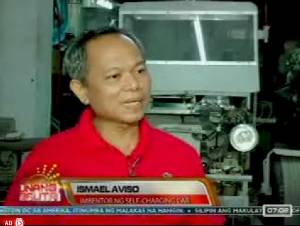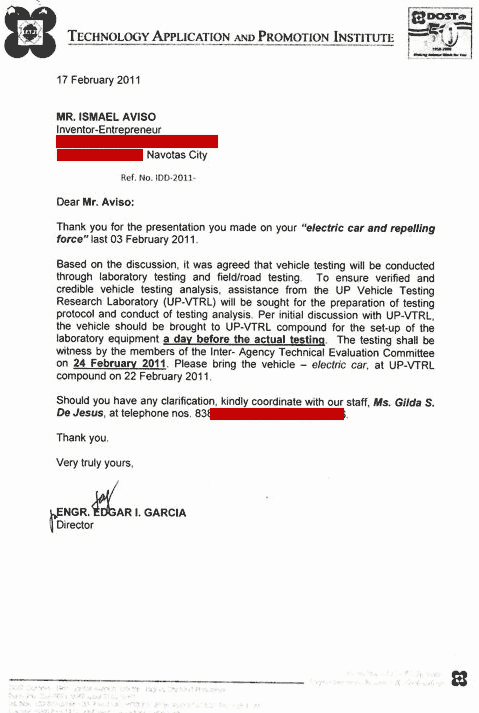Philippine DOE Verifies Aviso's Self-Charging EV
Today, the Philippine Department of Energy tested Ismael Aviso's electric car, showing that running off wall power, the 11 kW DC motor ran at 45% efficiency, but with Aviso's on-board generator which harvests ambient energy from the surroundings, the motor ran at 133% efficiency (overunity).

Aviso's electric vehicle's back tires rest on a dynamometer in the DOE facility February 24, 2011. |
|
|
 Aviso's technology was featured on Channel 7 on Monday. |
![]()
by
Sterling D. Allan
Pure Energy Systems News
Major, breaking news here. Today in the Philippines, the
Department of Energy (DOE) validated a free energy technology we've been
reporting on recently. This is the first instance that I know of
in which a national DOE has validated overunity of any kind outside of
the conventional free energy technologies of solar, wind, geothermal,
tide, biomass, where the source of energy is always obvious.
Background of the Self-Charging EV
We are talking about an electric vehicle that can drive down the road
without having to stop to re-charge, because the energy is derived
onboard from the surroundings, in real time; in the tradition of
Nikola Tesla's Pierce Arrow.
The inventor, Ismael Aviso has posted videos showing himself and others
driving his electric vehicle down the road, and the single 12-Volt
battery that is connected to the 11-kilowatt DC motor doesn't run down,
but stays charged -- more than full, at 13 volts, as measured
periodically. Aviso estimates that once commercial, a retrofit of
an existing vehicle might cost around $4,000 retail – and this would
enable a once-petrol vehicle to be electric, with a battery pack that
stays charged, even as it is driving down the road.
The energy allegedly comes through an onboard antenna. In our last
story, I posted a 1.5-hour
interview I
had with him in which he described how the system works. Simply
put, he said he combines the high frequency shorting effect pursued by
Nikola Tesla, with the back EMF from the DC motor, to create a carrier
wave to harness ambient energy.
This invention is at the extreme cutting edge of free energy
developments; and now it has been validated by the Philippine DOE.
DOE Test Results
The Technology Application and Promotion Institute, a division of the
Philippine Department of Energy, tested two technologies developed by
Ismael Aviso: his electric car and his repelling force.
In testing the electric car, they compared the efficiency of the DC
motor using a conventional power supply (MERALCO), to the efficiency of
the DC motor using Aviso's power source. Their measurement
equipment included a dynamometer (which measures the torque produced by
the spinning wheel); and oscilloscopes, to measure electrical output.
They ran three tests of each type.
As was expected, the efficiency of the DC motor using the conventional
power supply coming from a wall outlet was 45%. More than half the
energy is being wasted as back-EMF, resistance, and heat.
But with Aviso's apparatus in place, the DC motor measured the
efficiency as 133% -- meaning that more energy was produced than was
consumed; validating the claim of "self-running" (with unseen energy
being harvested from the environment).
In his preparatory meeting with them last week, he told them that the
"conventional" mode will show the DC motor running at its rated
efficiency of around 65%, while the Aviso mode will show at least 90%
efficiency; and he told them he wouldn't be surprised if it showed 140%
efficiency – very clearly harnessing energy from the surroundings.
Now today, he nearly reached the 140% high projected.
In the repelling force test, his mode of propelling a one kilogram
weight 33 feet in the air consumed four times less energy than by means
of an ordinary low speed motor.
Aviso said the full test results report will be made available next
week, after which they will recommend the funding of his technology (not
by the Philippine government, which does not have the budget for this,
but by qualified third parties).
Evidence
Aviso provided the following
video of
today's testing, most of it in time-lapse mode to speed up the video.
Here's a letter that the department sent Aviso on February 14 to schedule today's test. It says that the testing would be witnessed by members of the Inter-Agency Technical Evaluation Committee at the UP-VTRL compound of the Technology Application and Promotion Institute, a division of the Department of Energy.

As mentioned in our last story about this technology, Aviso was featured Monday morning on Channel 7, the largest TV network in the Philippines. They accompanied him to the meeting with the Department of Energy on February 17, in which the proposed testing procedure was discussed. Here's the video of their coverage that they posted today on their site.
Test Data
On February 24, 2011 7:38 PM Aviso provided the following:
(grammar slightly edited)
| Subject: Testing figure Testing DATA 5 Test 1 Meralco: 1,300watts/ 6.4amps./ 223 V Dyno: 291 Newton / 570 watts Aviso tech: 308 watts/ 13amps / 23.74 v Dyno :210 Ntwn / 418 watts Test 2 Meralco: 2000watts/ 9.5Amps / 227V V Dyno: 455 Newton / 931 watts Aviso tech: 306 watts/ 13amps / 23.6V Dyno: 210 Newton / 402 watts Test 3 Meralco: 2,300watts / 10.98amps / 229V Dyno: 507 Newton / 1,100 watts Aviso tech: 306 watts/ 13amps/ 23.56 V Dyno: 200 Newton / 389 watts We drove outside about 100 meters & back again to LAB & again some testing; inasmuch as they found two sets of batteries 7amps/12V in front of the car. I told them that it was a supply only for the fan and microcontroller; but they didn't believe me; so we test again for the 4th time & confirmed no connection powering the motor & drops of volts & increase of current draw. Very minute draw of current only either on or off of the motor. Note: Actual Average time testing of AVISO tech 5 minutes. Two minutes running allocated for the DYNO computer setting up. Testing of repelling force. 6 times Conventional way of lifting a 1kilo coil & using conventional small 12V DC low speed motor. Height : 12 feet Average Time to reach 12 feet : Average Current draw : 0.93 amps Battery : 12V / 24AH FYMEGM repelling force by AVISO TECHN. 1Kilo coil 3 times repelling Battery start at 12.48 V end up 12.29V Average Height: 26 feet " Time: 1 sec Battery: 9 V + 1.5V AA + 1.5 AA = 12volts Note: I am not satisfied re: the Height reached, but I don't have time to adjust to full power. I told them, Once I receive enough funding, the next test will be 110 Kilometers per hour & until battery it run down. Ismael |
Miscellaneous
I spoke briefly this morning (MST) with "Konehead", the
forum member
who Aviso credits as being the most helpful in his being able to
accomplish what he has. Konehead articulated that the battery is
not the energy source basically serving as a buffer between the DC motor
and the high voltage on-board, on-demand source.
He did not seem to think that Aviso's technology would be a great
candidate for open sourcing (which includes a revenue stream for the
inventor's team). "It is too dangerous," he said, referring to the
repelling force, which involves 7500 volts of direct current (which
would be lethal). And the "MEG", standing for "motionless
electromagnetic generator", as he calls Aviso's electric car antennae
technology, is not simple.
There are a few people, apparently, who know how to do what Aviso
has accomplished; so he's not the only one.
I should also mention that in previous conversations, Aviso told me
that he would be interested in coming to the
Tesla Extravaganza in Vegas, the last weekend of June, which I've
been helping to organize. He could demonstrate his repelling force
effect. But even better than that would be if somehow he could
demonstrate the self-sustaining electric vehicle. That is what I
would like to aim for. I have not broached that idea with him yet.
He might need more intellectual property protection in place first.
# # #
This story is also published at
BeforeItsNews.
PESN.com
Copyright © 2002-2010,
PES Network Inc.